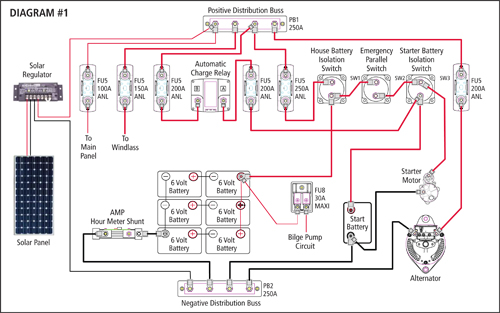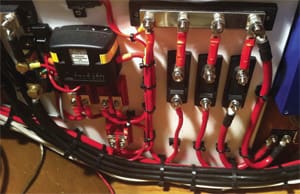On most vessels, the alternator is connected directly to the starter of the engine and while this is all right for charging the starter battery, it is not ideal for charging a large house battery bank. How do you wire the charging system to give priority to the house bank battery?
Usually, once the engine is started, you parallel the batteries and charge both battery banks at once. Every time you parallel your batteries, however, you drag down your starter battery by connecting it to a larger, often depleted house bank — not good for the starter battery. In my mind, the starter battery should never be compromised. So how do you wire the high amperage DC electrical system to do this? First and foremost it has to be simple; it also has to work automatically and has to be able to bypass any of the automated systems in case of failure.
There is more than one way to charge the batteries. You have, of course, the alternator but you also have other options such as solar panels, wind generators and water generators. So how do you combine all these charging sources into a simple distribution network to charge both the house and starter batteries? The first thing you do is create a common distribution point where all the charging sources and loads are connected. In our example system diagram (Diagram 1, see below), you will see we have two charging sources, solar and the alternator. You can have other charging sources, but for simplicity let’s stick to two for the moment.
System components
So what makes up this system? You have an automatic charging relay (ACR); three switches; house, parallel and starter isolation; positive and negative distribution busses; fuses and an amp-hour meter shunt. The amp-hour meter is crucial so that you can monitor your battery capacity. Nothing should bypass this shunt; all grounds should go to the negative distribution buss and not directly to the battery. Notice also that the alternator is connected directly to the positive distribution buss and not the starter.
Let’s say you have been at anchor for a while and your house bank is down to 50 percent capacity. You start your engine and the voltage at the positive distribution buss begins to rise as the house bank begins to charge. At this point, the starter battery is isolated from the house bank by the automatic charging relay (Diagram 2). Once the house battery voltage reaches 13.5 volts, the automatic charging relay closes and the starter battery is now charged in parallel with the house bank (Diagram 3). If the house bank is large, it might take a while for the automatic charge relay to parallel the batteries.
This of course works both ways. If you are anchoring for the night or sailing and the voltage at the positive distribution buss drops below 12.35 volts, the automatic charging relay opens the starting circuit preventing the starting battery from being discharged. This all takes place without having to turn on or off any switches.
You will notice in Diagram 1 that there are only on/off switches used; there are no 1/2/both switches. This is done for simplicity; each switch has its own function: house battery isolation, parallel and starter isolation. The house battery isolation switch does as the name suggests: isolates the house batteries from the positive distribution buss. With the exception of the bilge pump circuit, everything is electrically isolated when this switch is in the off position.
Two important points
Notice that the house bank’s main fuse is after the switch. Normally, the main fuse is as close as possible to the battery but because the cable going to the isolation switch from the battery is part of the starting circuit when the parallel switch is closed, it does not need to be fused. If the starter battery is too weak to start the engine, the house bank can be paralleled to the engine start battery using the emergency parallel switch to aid in engine starting. Notice also that the starter isolation switch is wired in such a way so that if the start battery is completely dead or shorted it can be isolated and the motor can be started using only the house bank. The parallel switch can also be used if the automatic charging relay fails; you simply parallel the house and starter battery to charge them. You, of course, have to make sure that you un-parallel them when no charging source is available so that you do not bring down your start battery when your house bank is being discharged.
The system works the same way with the solar panel. During the day, when the solar panel voltage rises above 13.5 volts, the starter battery is automatically connected in parallel with the house bank and at night when the voltage drops below 12.35 volts, it is disconnected.
So as you can see, without adding any real complexity, you can wire a boat in such a way as to make it seamless in regards to battery charging. In other words, you do not have to turn battery switches “off” and “on” to charge the different batteries. This system keeps it simple and reliable, and at the same time protects the starter battery from being accidentally discharged.
James Turnbull owns Nautek Marine Electrical Inc. in Victoria, BC. Contact him at nautek@shaw.ca.
 |
 |
 |
|
Pat Rossi/Ocean Navigator |

